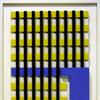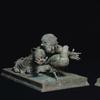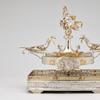'America after the Fall: Painting in the 1930s' at Art Institute of Chicago
- CHICAGO, Illinois
- /
- May 17, 2016
What is American art? That is a question the country’s artists asked and answered in myriad ways during the decade spanning the economic crash of 1929 through America’s entry into World War II. With economic downturn at home and the rising threat of fascism abroad, artists of the time applied their individualized visions of the nation to rethinking modernism.
The Art Institute of Chicago exhibition "America after the Fall: Painting in the 1930s," from June 5, 2016–September 18, 2016, brings together 50 works by some of the foremost artists of the era—including Edward Hopper, Georgia O’Keeffe, and Grant Wood—to examine the landscape of the United States during the Great Depression and the many avenues artists explored as they sought to forge a new national art and identity.
Collectively, the aesthetically and politically varied works produced in the 1930s paint a revealing portrait of the nation’s evolving psyche. Edward Hopper’s reflective, melancholy approach to homegrown subjects is quite different from the bold romanticism of Thomas Hart Benton and his fellow Regionalists, who sought to create a national art that glorified America. Painters such as Philip Evergood and Ben Shahn used social realism to protest political attitudes of the time, highlighting the plights of migrant sharecroppers, Jewish immigrants, and other marginalized members of society. Racial issues also came to the fore: Joe Jones chillingly depicted a lynching in American Justice, while Aaron Douglas inserted a more inclusive vision of black culture into the heroic histories of the United States. History, in fact, was frequently used to speak to present times; realist Charles Sheeler linked the earlier, spare American aesthetic of Shaker objects to his exploration of the contemporary, while Grant Wood took on the country’s founding myths in works such as Parson Weems’ Fable.
At the same time, other artists reinvigorated the revolt against representational style, championing nonobjective art as a form that spoke deeply to modern concerns. The Park Avenue Cubists continued to evolve a European-based abstraction, and modernists such as Stuart Davis and Charles Demuth applied a precise, geometric vocabulary to American architecture and advertising.
Bringing these diverse works of art together, America after the Fall tells the story of a nation’s fall from grace and irrevocable changes to the American dream. Following its installation at the Art Institute, the exhibition travels to the Musée de l’Orangerie in Paris and London’s Royal Academy, marking the first time many of these iconic American works—including Grant Wood’s American Gothic—have journeyed beyond North America. For French and British audiences, this traveling exhibition offers an unprecedented opportunity to experience these masterpieces firsthand. For all the show’s visitors, the presentation affords a trailblazing look at the turbulent economic, political, and aesthetic world of the 1930s and the critical and dynamic process of rethinking modernism that it fostered.
The exhibition is also on view at Musée de l’Orangerie, Paris, France (October 12, 2016– January 30, 2017); and the Royal Academy of Arts, London, England (spring 2017).
















